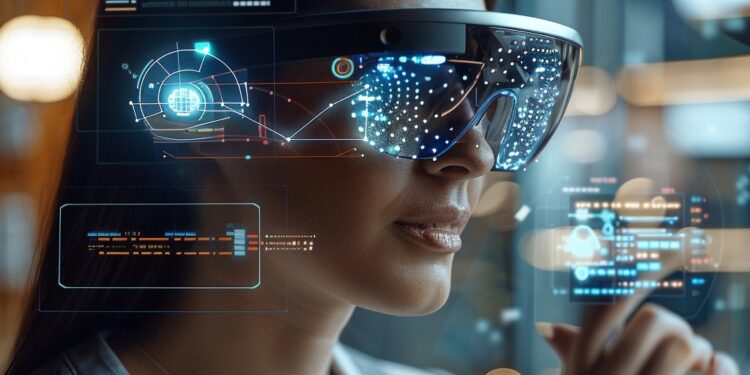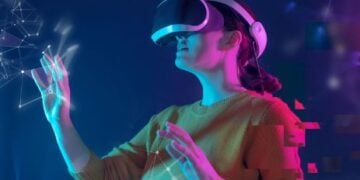Augmented Reality In Digital World delves into the transformative power of AR technology, exploring its impact on various sectors from marketing to education. This engaging narrative sheds light on how AR is reshaping our digital experiences and revolutionizing the way we interact with the world around us.
From enhancing customer engagement to revolutionizing classroom learning, AR is at the forefront of innovation, offering endless possibilities for businesses and educators alike.
Understanding Augmented Reality
Augmented reality (AR) is a technology that overlays digital information such as images, videos, or 3D models onto the real world. It enhances the user’s perception of reality by superimposing virtual elements onto the physical environment through a device like a smartphone or AR glasses.
AR enhances real-world experiences by blending the physical and digital worlds seamlessly. It allows users to interact with virtual objects in a real-world setting, creating immersive and engaging experiences. For example, AR can be used in gaming to bring characters and objects into the player’s environment, providing a more interactive and dynamic gameplay experience.
Popular Augmented Reality Applications and Games
- Pokémon GO: One of the most popular AR games, Pokémon GO allows players to catch virtual Pokémon in real-world locations using their smartphones.
- Snapchat Lenses: Snapchat filters use AR technology to add fun and creative effects to users’ photos and videos, transforming their appearance in real-time.
- Google Maps AR Navigation: This feature overlays directions and navigation cues onto the real world, making it easier for users to navigate unfamiliar locations.
- IKEA Place: This app lets users visualize how furniture would look in their own space by placing virtual IKEA products in their rooms using AR technology.

Impact of Augmented Reality
Augmented reality (AR) has revolutionized digital marketing by providing businesses with innovative ways to engage with their target audience. By overlaying digital information onto the physical world, AR offers a unique and interactive experience for consumers. This technology has transformed the way companies approach marketing strategies, leading to increased customer engagement and brand awareness.
Utilization of Augmented Reality
Businesses across various industries are incorporating augmented reality into their marketing campaigns to create a more immersive and personalized experience for consumers. Some common ways in which AR is used in marketing include:
- AR-powered product visualizations: Companies can use AR to allow customers to visualize products in their own environment before making a purchase, leading to increased confidence in their buying decisions.
- Interactive AR ads: Brands can create interactive AR ads that engage users and provide a memorable experience, ultimately driving higher conversion rates.
- AR-powered games and experiences: By developing AR games and experiences, businesses can attract and retain customers in a fun and engaging way, increasing brand loyalty.
Enhancement of Customer Engagement through Augmented Reality
Augmented reality enhances customer engagement by offering a more interactive and personalized experience, ultimately leading to increased brand loyalty and customer satisfaction. Some ways in which AR enhances customer engagement include:
- Personalized shopping experiences: AR allows customers to virtually try on products or visualize how items will look in their space, creating a more personalized shopping journey.
- Interactive storytelling: Brands can use AR to tell compelling stories that resonate with consumers on a deeper level, fostering emotional connections and brand loyalty.
- Engaging promotional campaigns: By incorporating AR into promotional campaigns, businesses can create buzz and excitement around their products or services, driving customer interest and engagement.
Benefits of Incorporating Augmented Reality
There are numerous benefits to incorporating augmented reality into digital marketing campaigns, including:
- Increased customer engagement: AR creates a more interactive and immersive experience for consumers, leading to higher levels of engagement with brand content.
- Enhanced brand awareness: By leveraging AR technology, businesses can differentiate themselves from competitors and create memorable experiences that resonate with consumers.
- Improved conversion rates: AR has been shown to increase conversion rates by providing customers with a more realistic and personalized view of products, leading to more confident purchasing decisions.
Augmented Reality in Education
Augmented reality has been making significant strides in transforming the education sector by enhancing traditional learning methods and providing immersive experiences for students.
One of the key advantages of using augmented reality in learning environments is the ability to engage students in a more interactive and hands-on way. By overlaying digital content onto the physical world, students can visualize complex concepts, explore 3D models, and interact with virtual objects, making the learning experience more engaging and memorable.
Advantages
- Enhanced Learning Experience: AR technology can provide a more interactive and immersive learning experience, making it easier for students to understand complex concepts.
- Increased Engagement: By incorporating AR into lessons, students are more likely to stay engaged and interested in the material.
- Personalized Learning: AR allows for personalized learning experiences, catering to individual student needs and learning styles.
- Real-World Applications: AR can help bridge the gap between theoretical knowledge and real-world applications by providing simulations and practical examples.
Examples of Educational Tools/Platforms with Augmented Reality Integration
- Google Expeditions: This platform allows teachers to take their students on virtual field trips using AR technology, providing a more immersive and interactive learning experience.
- Zappar: Zappar offers a range of educational AR experiences, from interactive storytelling to 3D modeling, allowing students to explore various subjects in a unique way.
- DAQRI Smart Glasses: These smart glasses provide AR-enhanced learning experiences, allowing students to interact with digital content overlaid onto the physical world.
Challenges and Limitations of Augmented Reality
Augmented Reality (AR) has the potential to revolutionize various industries, but it also comes with its own set of challenges and limitations. These obstacles need to be addressed to fully harness the benefits of AR technology.
Common Challenges Faced in Implementing Augmented Reality Technologies
Implementing AR technologies can be complex and challenging due to various factors such as:
- Hardware Limitations: AR experiences often require sophisticated hardware components such as sensors, cameras, and displays. Ensuring compatibility and integration of these components can be a challenge.
- Software Development: Developing AR applications requires specialized skills and knowledge. Finding experienced developers who can create seamless and user-friendly AR experiences can be difficult.
- User Adoption: Convincing users to adopt AR technology can be a challenge, especially if they are not familiar with the concept or if the technology is perceived as complex or intrusive.
- Data Privacy and Security: AR applications collect and process a significant amount of data, raising concerns about privacy and security. Ensuring compliance with data protection regulations is essential.
Overcoming these challenges requires collaboration among hardware manufacturers, software developers, and regulatory bodies to create a robust AR ecosystem.
Limitations of Current Augmented Reality Systems
Despite advancements in AR technology, there are still limitations that need to be addressed, including:
- Field of View: Current AR systems have limited field of view, restricting the user’s ability to interact with virtual objects in a natural way.
- Latency: Latency issues can disrupt the immersive experience of AR applications, leading to delays in real-time interactions.
- Environmental Factors: AR performance can be affected by environmental factors such as lighting conditions, obstacles, and spatial limitations.
- Content Quality: The quality of AR content, including graphics and animations, can vary widely and impact the overall user experience.
Addressing these limitations requires continuous research and development to improve hardware capabilities, optimize software performance, and enhance user interactions.
In conclusion, Augmented Reality In Digital World showcases the boundless potential of AR technology and its ability to revolutionize industries. As we continue to embrace AR in our daily lives, the future holds exciting possibilities for a truly augmented digital world.












